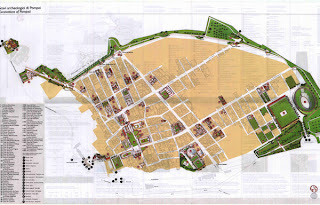 |
| Map of the Pompeii available for free with the entrance ticket |
In the meantime, I want to transcribe some notes about the first information I gathered, very informally, from
* people I met on site and during my visit at the museum of Naples
* people I have met in the subsequent days but have agreed to share with me their opinions and experiences.
On site:
People tend to arrive on site with a high level of expectation. Everybody knows about the tragic end of Pompeii and everybody knows that it is one of the most precious archaeological resources of the world.
I have approached tourists that were not part of a guided tour for obvious reasons. Often they were couples. Some of them had a published touristic guide, others just the leaflet that the ticket office gave them.
They all appreciated the opportunity to wander freely in the site (they often defined it as “a wonderful opportunity”) but, on the other hand, they all lamented a certain lack of information.
Having some of them long and detailed touristic guides, my reckoning is that they were not just looking for more written information. A couple I interviewed in Herculaneum explicitly said that they don’t like (and didn’t expect) informative panels because they spoil the archaeological landscape. Moreover, I would add that it is very difficult to deal with all the languages spoken by tourists in Pompeii (or even just with the 2 or 3 most common ones).
One of the most frequent complains I have heard was the difficulty in perceiving the Pompeian dwellings as places that used to be “lived”. All the visitors I have interviewed were, to a certain extent, looking for a sort of emotional experience. But, for a tourist (even a motivated one) it is hard to understand how spaces were used in the past. This seems to provoke a certain level of frustration. Tourists would have liked to see objects (even reproductions) and furnitures in the houses. Some of the interviewed people have even asked me to explain why none of the objects have been left in place. When I told them that original artefacts would be damaged or nicked if left in place, they asked why not even reproductions are now available.
The truth is that is not easy. Pompeii is a large and complex site, very difficult to manage. Every choice seems to make someone unhappy and finding a balance between authenticity and communication is a real challenge.
My intention is not to criticise the policies of the site management, but to report what I have heard from tourists. One of them, for example, suggested that at least one exemplar house should be restored and refurbished to show how they used to be.
One of the most precious information for my research is that, apparently, what tourists miss is both cognitive and emotional. They would like to know more, to understand more. At the same time, they want to “feel” that they are walking the streets of what used to be a city with passers by, sellers, customers, children, animals etc... This is probably why they feel that a book or a panel would not be enough. Objects, on the other hand, appear to have a strong emotional and communicative value. From these first results, it seems that is through objects that the connection with the past works better.
Probably looking at objects, tourists can imagine ancient inhabitants of the city using them in their everyday life. Or, more simply, the presence of objects is what identifies a space as a domestic space (or a ritual one or a commercial one and so on but always as a "human" space).
Thanks for your grateful informations, am working in Tourism Portal, so it will be helpful info for my works.
ReplyDelete